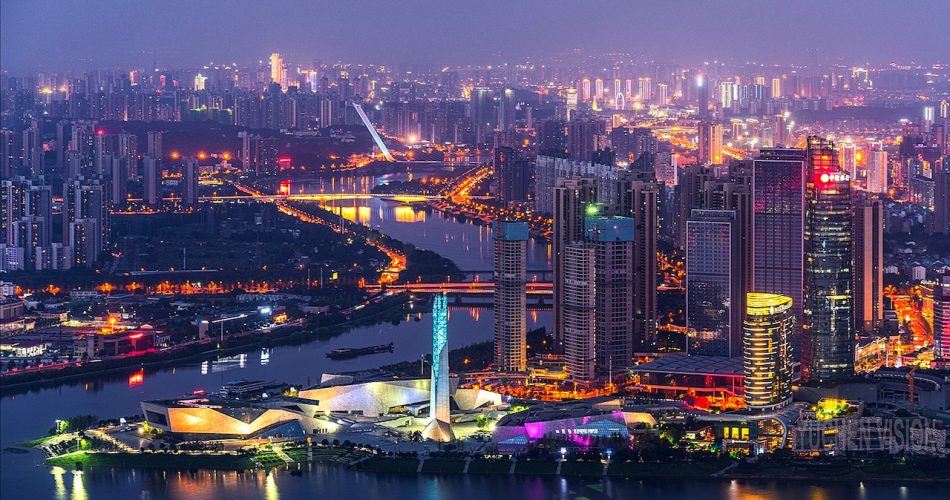Hunan is a Chinese province with beautiful natural scenery and very rich historical and humanistic landscapes.
This province is home to world-famous geological wonders such as Zhangjiajie, Hengshan Mountain with its global reputation, Phoenix Ancient Town, the poetic, picturesque and dreamy Dongjiang Lake, and Shaoshan, the birthplace of the great man, Mao Zedong.
This article will guide you to enjoy the beautiful scenery of Hunan by introducing the top 11 famous attractions in this province.
Table of Contents
- 1. Zhangjiajie Wulingyuan – National Forest Park
- 2. Tianmen Mountain
- 3. Hengshan Mountain
- 4. Changsha Orange Isle
- 5. Yueyang Tower
- 6. Yuelu Mountain in Changsha
- 7. Fenghuang Ancient Town
- 8. Dongjiang Lake
- 9. Shaoshan (the birthplace of Mao Zedong, a place in Hunan Province)
- 10. Mangshan
- 11. Changde Peach Blossom Garden (Taohuayuan)
Hunan, named for its location to the south of Dongting Lake, is known simply as “Xiang” (“湘”) with Changsha being its capital.
Hunan Province is one of the multi-ethnic provinces with a large land area. It has both natural landscapes and historical and humanistic landscapes. Fifty-five ethnic groups, including the Han, Miao, Bai, and Tujia, together constitute the unique Hunan culture.
So, what are the attractions worth visiting in such a special province? Let’s find out together.
1. Zhangjiajie Wulingyuan – National Forest Park

The most worthwhile attraction in Hunan can be Zhangjiajie Wulingyuan. Wulingyuan Scenic Spot is one of China’s famous tourist attractions, a national 5A-level tourist area, one of the earliest places listed in China’s World Natural Heritage.
The natural scenery of Wulingyuan is characterized by wonderous peaks, deep valleys, and beautiful forests. There are more than 3,000 wonderous peaks in the shapes of people, beasts, vessels, and objects, with realistic and spectacular images.
Yellow Stone Village, Golden Whip Stream, and Yuanjiajie in the National Forest Park are the core attractions of Zhangjiajie. Huangshizhai is the most worthwhile attraction in Zhangjiajie Forest Park, and it is said that “if you don’t go to Huangshizhai, you’ve been to Zhangjiajie in vain”.
- Ticket: $227 per person
- Time to visit: March-May
- Excursions: hiking, sightseeing, rafting, etc.
2. Tianmen Mountain
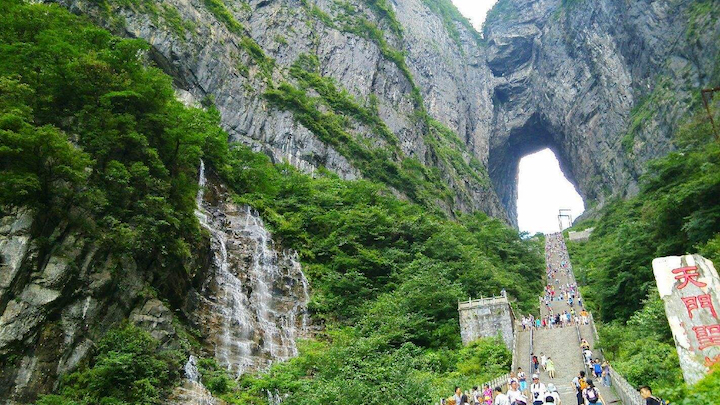
Known as the “Number One Mountain Gate in China” and named after the natural wonder “Tianmen Cave”, Tianmen Mountain is one of the most famous peaks in China. It is known as the “First Divine Mountain in Xiangxi” and “Soul of Wuling”.
The Tianmen Mountain uplift began with the Yanshan Movement, and then underwent the Himalayan orogeny, creating the main body of this uplift. Through strong erosion and leaching, this uplift formed the current karst mountain landscape.
Tianmen Mountain integrates majesty, wonder, beauty, danger, and seclusion. The mountaintop forest is a primitive sub forest, with a variety of precious tree species and abundant wildlife resources.
In this forest, ancient trees tower high above the sky, vines are entwined, and stalagmites and stalagmites are everywhere, resembling a natural bonsai. It is known as the world’s most beautiful ‘Sky Garden” and “Heavenly Wonderland”.
- Admission: 258 yuan/person
- Opening Hours: 7:00-16:00
- Recommended travel time: spring and autumn
- Recommended amusement project: glass walkway
3. Hengshan Mountain

The Scenic Area of Hengshan Mountain is one of the five most famous mountains in China. As a famous Taoist and Buddhist holy place in China, Hengshan Mountain boasts over 200 temples, monasteries, nunneries, and temples around the mountain, which makes it a worthwhile place to visit in Hunan.
The high aptitude of Zhu Rong Peak of Hengshan Mountain, the beauty of the Hall of Buddhist Scriptures, the uniqueness of the Water Curtain Cave, and the depth of the Fang Guang Si (a temple) are known as the “Four Perfections of Hengshan”.
Spring flowers, summer clouds, autumn sun, and winter snow are “the Best Sceneries in Hengshan Mountain in the Four Seasons”.
This mountain has many natural sceneries and cultural heritages, such as Longwang Temple, the Cliff of Thinking, and Yangguan Village, etc. So, it is a comprehensive scenic spot with a variety of tourism resources.
- Recommendation reason: Being able to experience Taoist culture and natural scenery.
- Recommended time: suitable for all seasons
- Amusement projects: mountain climbing, visiting Taoist temples, paying respects, and so on.
4. Changsha Orange Isle

Changsha Orange Isle is one of the most famous tourist attractions in Changsha City, Hunan province. Facing Changsha City to the east, facing Yuelu Mountain to the west, and surrounded by water on all sides, Changsha Orange Isle is located in the middle of the Xiangjiang River, running from south to north across the river center and resembling a long island.
Famous for Mao Zedong’s poetry “Qinyuan Spring • Changsha”, Changsha Orange Isle is known as the “First Isle of China”.
There are many scenic spots on Orange Isle, including Youth Art Sculpture, Wentian Terrace, Orange Island Park, Zhenjiang Pavilion, Gongji Tower, Isle Head Square, Bamboo Garden, Baimu Orange Garden, Tingjiang Pavilion, and Xiaoxiang Celebrity Club. These spots complement each other.
- The scenic area has a large area, so it is recommended to take a sightseeing train at 40 yuan/person (50% discount for students);
- Fireworks will be displayed on New Year’s Day, Mid-Autumn Festival, the Lantern Festival, May Day, and other traditional festivals every year;
- You should pay attention to the weather forecast in advance, and if it rains heavily, Orange Isle will be closed.
5. Yueyang Tower
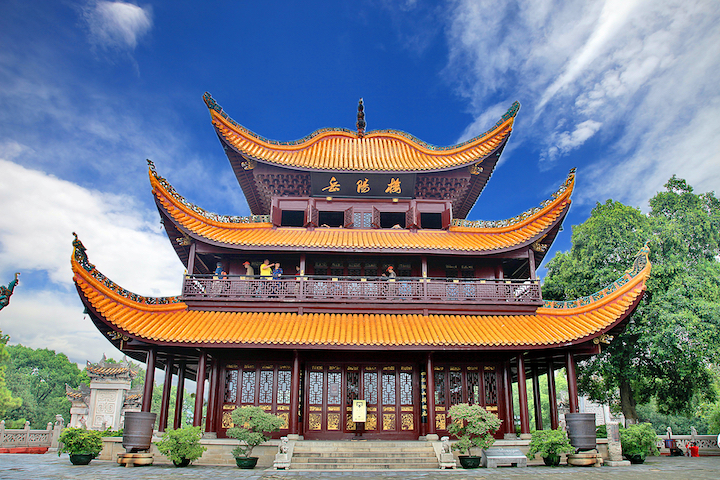
Yueyang Tower is a national 5A-level tourist scenic area, a key cultural relic protection unit in China, and one of the top ten cultural heritage sites in Hunan province. It is known as the “Three Famous Buildings in South of the Yangtze River”, with Huanghe Tower and Tengwang Pavilion.
Yueyang Tower was built during the Eastern Jin Dynasty, and it has a history of over 1700 years. Climbing up the tower, one can overlook the beautiful scenery of the entire Dongting Lake.
Yueyang Tower is 19 meters high, and it is made of wood with three floors, four columns, cornices, an arch of wooden architecture, and a helmet roof. The entire building adopts a purely wooden structure, without using a single nail or rivet, all relying on the interlocking of wooden components.
Li Bai, Du Fu, Bai Juyi, Fan Zhongyan, and many other historical figures have visited Yueyang Tower and left poems that have been passed down through the ages.
- Recommendation reason: You can enjoy one of the famous scenic spots in Hunan and enjoy the beautiful scenery of Dongting Lake;
- Recommended time: suitable for traveling in spring and autumn, with a suitable climate;
- Amusement projects: climbing to view the scenery and visiting the exhibition halls inside the building
6. Yuelu Mountain in Changsha
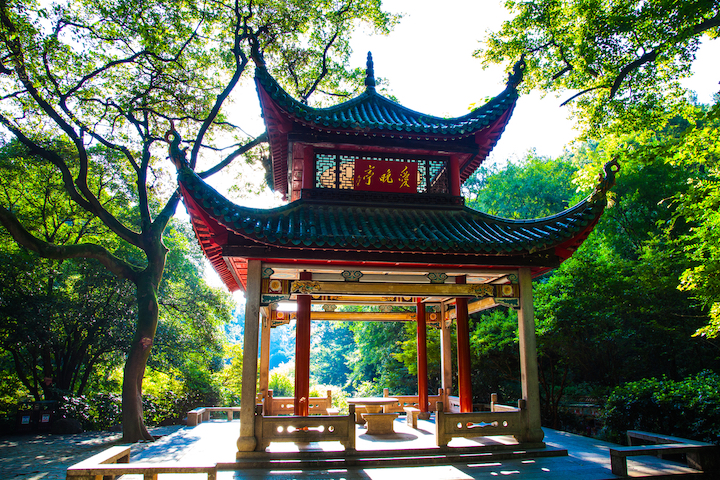
Yuelu Mountain is a landmark mountain in Changsha, located in the Orange Isle tourist attraction. It is the last peak of the 72 peaks of Hengshan Mountain and one of the four major destinations for maple viewing in China.
Yuelu Mountain boasts beautiful natural scenery and cultural heritage, with famous scenic spots such as Yuelu Academy, Aiwan Pavilion, Lushan Temple, and Yunlu Palace. The mountains are lush with ancient and famous trees.
The famous scenic spot, Yuelu Academy, was founded in the ninth year of Kaibao in the Northern Song Dynasty. It is known as the four ancient Chinese academies, along with the Bailudong Academy, Songyang Academy, and Suiyang Academy.
There is a pair of couplets at the entrance, “Genius is all in CHU, especially in the Yuelu Academy”, which is widely circulated.
- Admission: free for the Gate; RMB40 for Yuelu Academy
- Recommended time: In December of each year, red leaves come into your sight. Aiwan Pavilion and Huangxing Tomb are good places to see red leaves.
- Opening Hours: 07:00-22:00
7. Fenghuang Ancient Town
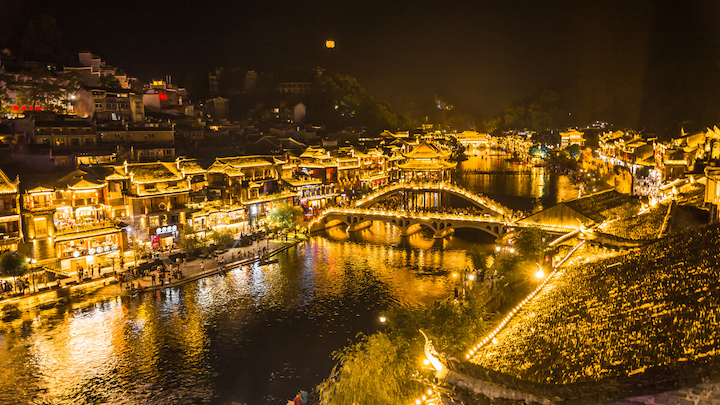
Fenghuang Ancient City is a minority community mainly composed of 28 ethnic groups.
It is a national 4A level scenic area and has been awarded honorary titles such as “National Historical and Cultural City”, “National Key Cultural Relics Protection Unit”, and “Top Ten Cultural Heritage Sites in Hunan”.
Fenghuang Ancient City is located in the southwest of Xiangxi Tujia and Miao Autonomous Region, covering an area of 10 square kilometers. There are numerous antique buildings including Chaoyang Palace, Ancient City Museum, and Yang Family Ancestral Hall.
This ancient city is also known as one of the most beautiful places in China with its excellent scenery.
- Tour Route: Hongqiao – Dongmen City Tower – Yang Family Ancestral Hall – Chongde Hall – Tianhou Palace – Longnan – Shen Congwen’s Former Residence – South Gate – Chaoyang Palace – Dacheng Hall – Jiang Tiaoyan – Tuojiang – Hangjiao Tower
- Festival activities: New Year’s Eve, “Sanyuesan Festival” (The Zhuang Nationality March 3), “Tomb Sweeping Day”, and “April 8th” and “June 6th” of the Miao nationality.
Precautions:
- Do not enter the house with an umbrella;
- Do not casually step on the threshold;
- When visiting Miao families, do not take the main seat in the main hall;
- Coins are not allowed in the ancient city of Phoenix. It is best to prepare cash when you travel to the city.
8. Dongjiang Lake
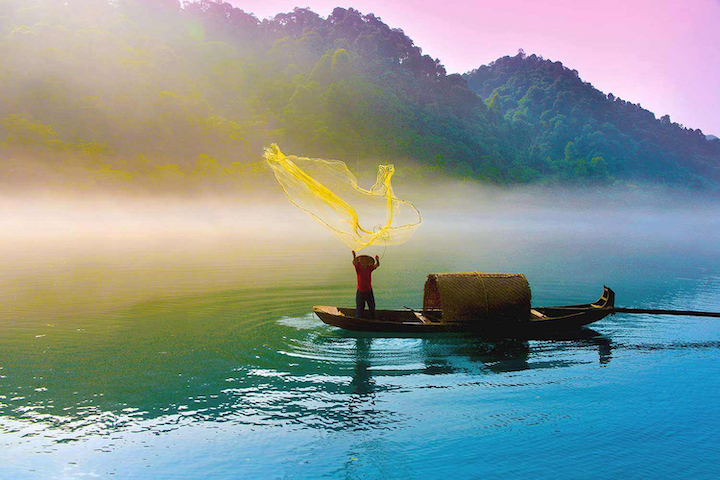
Dongjiang Lake is a national 5A level tourist attraction, national scenic spot, national wetland park, and national water conservancy scenic area. It is also the largest source of drinking water in Hunan Province.
“There is a lake in the sky on earth, with a thousand sights in it,”, which is how Chinese people praise the lake.
Dongjiang Lake is located in Zixing City in the southeastern Hunan Province. It is surrounded by the south of the Nanling Mountain and Luoxiao Mountains, and it is also one of the sources of Lei Shui drainage.
The lake covers an area of 160 square kilometers. It has a vast expanse of smoke and blue waves. The Water Mist in Dongjiang Lake is titled “Chinese Wonder and Cosmic Wonder”.
From April to November every year, before and after the sun rises and sets, from the gate of Dongjiang Scenic Area to the narrow Pinghu Lake of Xiaodong River, which is 12 kilometers away from Dongjiang Dam, the clouds are shining brightly, like a jade belt fluttering in the canyon and wandering in a fairyland. It is extremely beautiful and can be called a masterpiece of China.
The best time for observing mist:
- 1. From April to October every year, from 6:30 am to 8:30 am and from 17:30 pm to 19:30 pm, it is the best time to observe the mist;
- 2. There is no fog on rainy days, and the fog will be relatively small on cloudy days.
The main landscapes: Wuman Xiaodong River, Dongjiang Dam, Longjing Canyon, Doubi Lingyan, Dongjiang Drifting, Sanxiang Sishui Dongjiang Cultural Tourism Street (including Dongjiang Qishi Museum, Photography Art Museum, and Humanities Xiaoxiang Museum);
Tourist Projects: Dongjiang rafting, water parachuting, water plane, water motorcycle, water slide, lakeside fishing, Yao folk song, and dance performances.
9. Shaoshan (the birthplace of Mao Zedong, a place in Hunan Province)

If you don’t visit Shaoshan when you come to Hunan province, you cannot say that you have been to Hunan province. Shaoshan is the hometown of the great leader Chairman Mao, as well as the place where he lived, studied, worked, and engaged in revolutionary activities in his youth.
Shaoshan, with its graceful and beautiful scenery, is named after Emperor Shun’s southern tour to play Shao music. It is a place of diverse great people and pleasant sceneries. Shaofeng is also the highest peak in the scenic area, with an altitude of 519 meters. It is the highest peak and one of the 72 peaks in Hengshan Mountain.
- Famous tourist attractions: Mao Zedong’s Former Residence and Dishui Cave
- Admission: Free at the entrance of the scenic area, Mao Zedong Memorial Park: RMB60 for adults, half-price (RMB 30) for children; A peak in Shaoshan scenic area: RMB40, Dishui Cave: RMB40 for adults.
- Travel time: Shaoshan is a scenic area suitable for traveling in all four seasons, but it is recommended to travel in this sight for 2.5 hours.
10. Mangshan
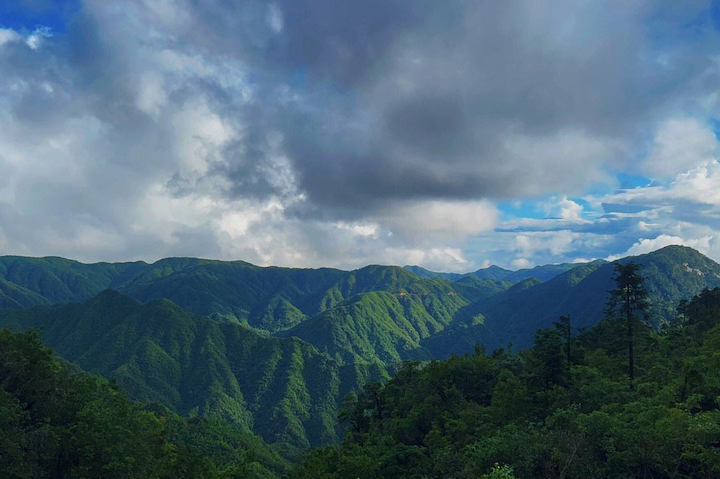
Mangshan National Forest Park, a national 4A scenic spot, is also known as “Little Mount Huangshan” and “Little Zhangjiajie” because of its strange mountains, beautiful water, secluded forests, and strange rocks.
This scenic area has the largest and most well-preserved native evergreen broad-leaved forest in the same latitude zone on Earth, as well as abundant animal and plant resources.
There are more than 50 nationally-protected animals, including the giant panda, and the southern yew, earning it the nickname of “Green Pearl” and “Animal and Plant Gene Bank”.
Mangshan consists of two scenic spots: Forest Park and Five Finger Peak (Wuzhifeng Peak). The forest park covers a large area and contains three attractions: General’s Cottage, Tiantai Mountain, and Monkey King’s Cottage. Five Fingers Peak is connected to the forest park, but it is also a separate scenic spot.
- Tour Route: East Gate→Ropeway Wuzhifeng Station→Ropeway Upper Tiantai Temple Station→Trestle Middle Line→Canyon Restaurant→Motianling Elevator→Trestle Upper Line→Small Tiantai→Tiantai Temple→Tiantai Trail→Trestle Middle Line→Ropeway Tiantai Temple Station→Ropeway Wuzhifeng Station→East Gate
- Travel recommendations: due to the high elevation of the scenic area, with an average height difference of 1300 meters, and the changing climate, please take rain gear and coats to prevent cold and warm weather
- Travel time: spring, summer, autumn
11. Changde Peach Blossom Garden (Taohuayuan)
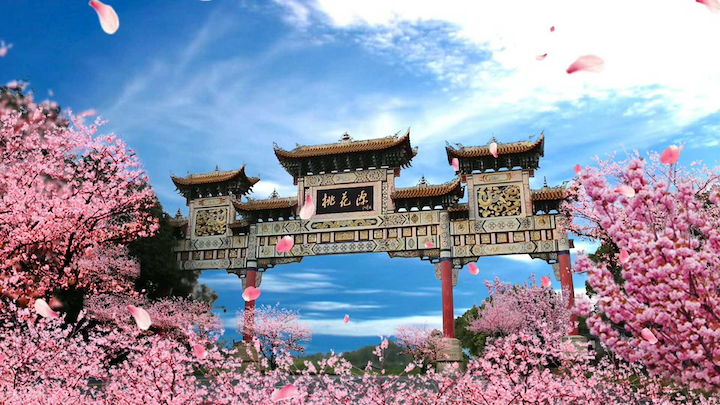
Changde Peach Blossom Garden has been rated as one of the “Eight Cultural Landscapes in China that Must Be Visited in a Lifetime” and one of the first of the ten cultural and tourism towns with distinct characteristics in Hunan Province.
The scenic area is renowned both domestically and internationally for its picturesque scenery, prosperous temples, pavilions, abundant poetry, inscriptions, and unique historical legends.
Within this garden, there are exquisite bamboo groves, intertwined with longevity vines, and fragrant flowers and plants. Decorated with stone steps, winding paths, pavilions, and steles, it feels like a fairyland.
Admission: 128RMB for adults, 61RMB for child/elderly/student;
Travel time: Available in all seasons. Spring is the most recommended time for a visit. Every year from late March to May, the scenic area holds the annual “Peach Blossom Festival”.
Recommended route:
- 1. Taoyuan Tourist Center → Wuliu Wharf → Boating Qinxi → Tang Shiqiao Wharf → Qingu → Qinjie → Wuliu Town → “Taohuayuan” Tourist Center.
- 2. Qinxi Square (Pier) → Boating Qinxi → Tang Shiqiao Pier → Qingu → Qinjie → Wuliu Lake → Wuliu Town → Performance with water in the mountain → Qinxi Square.
With this article, you can learn about the 11 major tourist destinations in Hunan province, each with its unique charm and characteristics.
